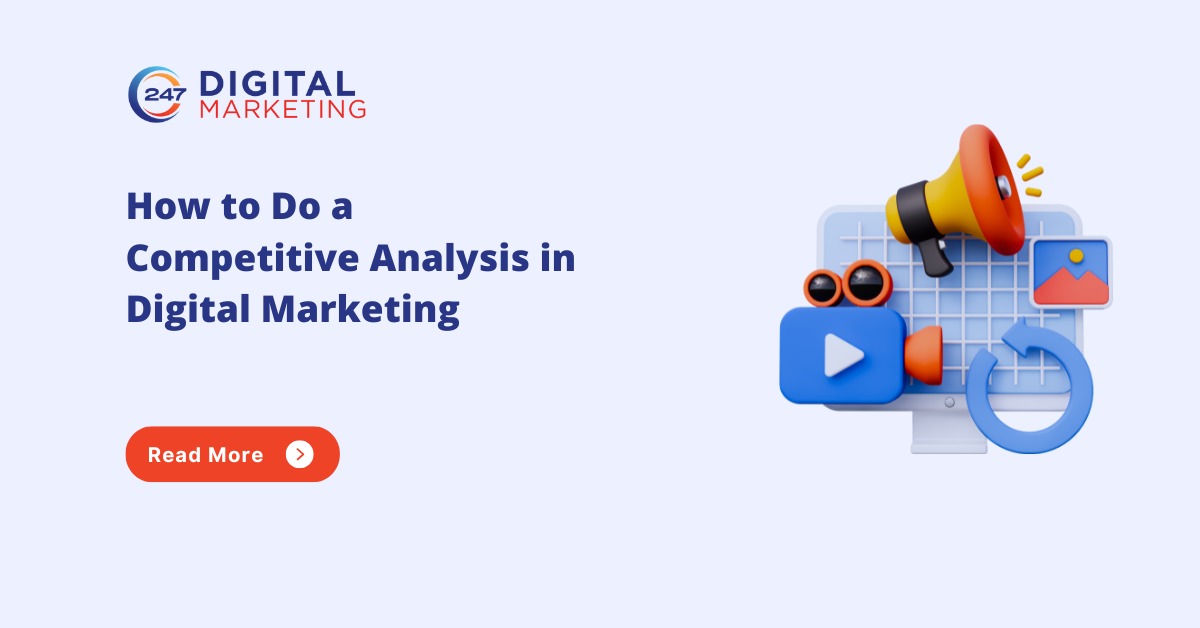
In the fast-paced world of digital marketing, staying ahead of the competition isn’t just a goal it’s a necessity. Every brand is vying for attention online, and understanding what your competitors are doing can help you find your unique edge. Conducting a competitive analysis allows you to dig deep into your competitors’ strategies, uncover opportunities, and refine your own digital marketing approach. Whether you’re a growing startup or an established Digital Marketing Agency in USA, knowing your competitors inside out can give you the leverage to build smarter campaigns and deliver measurable results.
In this guide, we’ll walk you through how to perform a competitive analysis in digital marketing, the frameworks and tools you can use, and how AI can make the process faster and more accurate.
What Is a Competitive Analysis in Digital Marketing?
A competitive analysis in digital marketing is the process of researching and evaluating your competitors to identify t heir strengths, weaknesses, strategies, and opportunities. It examines how other businesses in your niche approach digital marketing from SEO and PPC campaigns to social media and content marketing.
By analyzing these elements, you gain insights that can help you:
- Stay on top of industry trends.
- Discover new digital strategies for engagement and growth.
- Improve your brand awareness, customer experience, and revenue.
Essentially, it’s about turning your competitors’ data into actionable insights that fuel your own success.
Why You Should Do a Competitive Analysis
The purpose of a competitive analysis varies depending on your goals whether you want to optimize your website, refine your social media strategy, or launch a new product. But in all cases, it helps you identify where you stand in the market and how you can improve.
Key Benefits of Competitive Analysis:
- Identify market barriers and opportunities.
- Define your value proposition and differentiate from competitors.
- Highlight weaknesses in your competitors’ strategies.
- Target the most effective digital channels in your marketplace.
- Uncover potential customers and new market segments.
- Track industry trends to stay ahead.
- Identify new products or services worth pursuing.
- Establish benchmarks to measure your performance.
What Does a Competitive Analysis Include?
A comprehensive digital marketing competitive analysis involves evaluating your competitors’ presence across platforms and understanding how these contribute to their growth. Here’s how to approach it:
1. Determine Competitor Types
Not all competitors are the same. Categorize them into:
- Primary competitors: Direct competitors offering similar products to the same audience (e.g., Asos vs. Boohoo).
- Secondary competitors: Brands offering a variation of your product to a different market (e.g., Target vs. Gucci).
- Tertiary competitors: Companies related to your niche but not in direct competition (e.g., Red Bull and Patagonia).
This segmentation helps you prioritize which competitors to analyze most deeply.
2. Profile Your Competitors’ Target Customers
Understanding your competitors’ audience helps you discover new customer segments and refine your messaging. Analyze:
- Their About Us page or mission statement.
- Social media interactions and audience engagement.
- Blog content and downloadable assets.
- Webinars, podcasts, and customer reviews.
Through audience listening and content review, you can determine what type of messaging resonates most with their customers and how you can stand out.
3. Apply the 7Ps of Marketing
The 7Ps marketing mix provides a framework for analyzing your competitors’ strategies:
- Product: What are they selling, and what makes it appealing?
- Price: What pricing model do they use subscription, freemium, or one-time payment?
- Promotion: What channels do they use for digital promotion?
- Place: Where are they selling online, in-store, or both?
- People: Who represents the brand and interacts with customers?
- Process: How do they deliver their products or services efficiently?
- Physical Evidence: What visuals or materials reinforce trust (e.g., packaging, reviews, or case studies)?
Analyzing these factors can reveal actionable insights to enhance your digital marketing approach.
4. Find Best Practices
Your competitors are successful for a reason they’ve refined their strategies over time. Look at what they do best and determine whether you can adopt or improve on those tactics.
For instance:
- If multiple competitors are thriving on TikTok, it may signal an opportunity for your brand to build presence there.
- If others are climbing in search rankings, study their SEO practices keyword usage, content depth, and backlinks.
Learning from competitors’ best practices helps you avoid trial-and-error mistakes and accelerate your own results.
5. Use a Framework for Analysis
To structure your findings, apply proven analytical frameworks like:
- SWOT Analysis: Identifies your Strengths, Weaknesses, Opportunities, and Threats relative to competitors.
- Porter’s Five Forces: Evaluates competitive pressures in your industry, including new entrants and buyer power.
- BCG Growth-Share Matrix: Maps your products by market growth and share to identify where to focus resources.
Each framework helps you interpret your data strategically and make smarter decisions.
6. Organize Your Data for Analysis
Collecting data is only half the battle organizing it properly is key. Use spreadsheets or dashboards to group insights like:
- Competitor pricing models
- Social media engagement rates
- SEO keyword rankings
- Content marketing frequency
- Lead generation tactics
Organized data lets you identify trends, compare performance, and revisit information easily for future campaigns.
Types of Competitive Analysis in Digital Marketing
There are several types of competitor analyses you can conduct depending on your marketing goals.
1. Social Media Competitor Analysis
Social media marketing is vital for brand visibility and customer engagement. Analyze:
- Which platforms competitors use (Instagram, LinkedIn, TikTok, etc.)
- Post frequency, engagement rates, and follower growth
- Content types (videos, carousels, blog links)
- Customer interactions and feedback
Tools like Sprout Social or Facebook Ad Library can help monitor trends, engagement, and advertising strategies.
2. PPC Competitor Analysis
Paid advertising is highly competitive, and understanding your rivals’ PPC strategies can boost your ROI.
Analyze:
- Keywords they’re bidding on
- Ad formats and messaging
- Landing page design and CTAs
- Conversion or brand-awareness goals
Use tools such as SEMRush, SpyFu, or Google Ads Auction Insights to uncover paid keyword data and performance benchmarks.
3. SEO Competitor Analysis
SEO (Search engine optimization) remains a cornerstone of digital visibility. Analyzing your competitors’ organic strategies reveals valuable keyword opportunities.
Focus on:
- Comparing keyword rankings and gaps
- Backlink sources
- Page performance and speed
- Top-performing content themes
Tools like Ahrefs or SE Ranking provide detailed SEO insights, helping you optimize your own strategy to capture more organic traffic.
Top Tools for Competitive Analysis
SEO Analysis
- Ahrefs: Identify top-performing keywords and backlinks.
- SE Ranking: Monitor both organic and paid search performance.
PPC Analysis
- SEMRush: Perform site audits and keyword comparisons.
- SpyFu: Reveal competitors’ most profitable ad keywords.
- Google Ads Auction Insights: Compare your ad performance directly with competitors.
Keyword Research
- Similarweb: Understand keyword trends, web traffic, and engagement metrics.
Social Media Analysis
- Sprout Social: Track engagement, hashtags, and audience growth.
- Facebook Ad Library: Browse active ads across Facebook and Instagram.
AI Tools for Competitor Research
- Brandwatch: Monitor online brand mentions and sentiment.
- Sprout Social (AI features): Automate social data interpretation.
- ChatGPT: Use AI to analyze data from other tools and generate insights quickly.
- Google Trends, TikTok Creative Center, Meta Ads Library: Explore trending content and creative inspiration.
How AI Is Transforming Competitive Analysis
Artificial Intelligence is revolutionizing how marketers conduct competitor research. Instead of manually collecting and comparing data, AI tools automate the process analyzing trends, sentiment, and performance metrics across multiple platforms in real time.
With AI-driven insights, marketers can:
- Identify emerging trends faster.
- Predict competitor behavior.
- Optimize campaigns based on real-time data.
Tools like Brandwatch and ChatGPT allow you to synthesize massive datasets into actionable recommendations, making competitive analysis faster, smarter, and more precise.
Conclusion
Performing a competitive analysis in digital marketing is not a one-time task it’s an ongoing process that keeps your business agile and informed. By understanding what your competitors are doing well (and not so well), you can make smarter strategic decisions, identify growth opportunities, and stay ahead in a rapidly evolving digital landscape.
Start small: pick a few competitors, choose your tools, and dive into their digital footprints. As you analyze, you’ll gain the clarity and confidence to refine your strategy and achieve better results.
Drive Your Business Forward with Expert Digital Marketing Solutions
Achieving sustainable growth in today’s competitive market requires more than just an online presence it demands strategic planning and expert execution. By partnering with a trusted team offering Digital Marketing Services New York, you gain access to professionals who understand your audience, use advanced tools, and create tailored strategies that drive measurable results. From SEO and paid campaigns to content marketing and social media management, the right agency helps your brand stand out, attract qualified leads, and achieve lasting digital success.
Mitesh Patel is the co-founder of 247 Digital Marketing, LawFirm Marketing and a columnist. He helps companies like Emerson and other top Fortune 500 compnies to grow their revenue.





